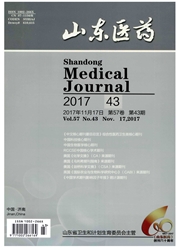

 中文摘要:
中文摘要:
目的:探讨制备穿膜肽-抗体-微球新型药物传送系统的可行性。方法:采用N-琥珀酰亚胺基-3-(2-吡啶二硫)-丙酸酯(SPDP)交联法将穿膜肽-增强型绿色荧光蛋白融合蛋白(CPPs-EGFP)、牛血清白蛋白微球(BSA-NS)、乙肝高效价免疫球蛋白(HBIg)分别采用一次偶联法和二次偶联法两种交联方案进行共价交联,采用还原和非还原SDS聚丙烯酰胺凝胶电泳(SDS-PAGE)和免疫荧光法评价穿膜肽、抗体、微球间的交联。结果:两种交联方案制备的穿膜肽-抗体-微球偶联物,SDS-PAGE还原电泳均可见在低分子量端形成三条蛋白条带,非还原电泳均未见条带;在不同激发波长的荧光显微镜下,均可见微球表面分别发出绿色荧光和红色荧光。结论:应用SP-DP交联剂,无论是一次偶联法还是二次偶联法均能够将穿膜肽、抗体、微球有效地进行偶联,为进一步研究穿膜肽-抗体-微球新型药物传送系统的特性奠定了基础。
 英文摘要:
英文摘要:
Objective:To explore the feasibility of applying N-succinimidyl-3-(2-pyridyldithio) propionate(SPDP) conjugation technology to the preparation of a new drug delivery system:CCPs-Antibody-Nanospheres conjugates.Methods:CCPs-Antibody-Nanospheres conjugates were prepared by two different methods of SPDP cross-linking. CCPs-Antibody-Nanospheres conjugates were tested by SDS-PAGE assay and immunofluorescent assay.Results:CCPs-Antibody-Nanospheres conjugates prepared by two different methods,which were reduced with DTT all showed three protein bands at low molecular weight end. There was brightest reaction in immunofluorescent.Conclusion:These data implicated that conjunction of cell-penetrating peptides,antibodies and nanospheres by two different methods of SPDP conjugation technology was successful and this would provide a basis for further studies on the new drug delivery system:CCPs-Antibody-Nanospheres conjugates.
 同期刊论文项目
同期刊论文项目
 同项目期刊论文
同项目期刊论文
 期刊信息
期刊信息
